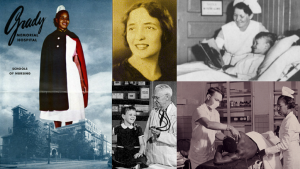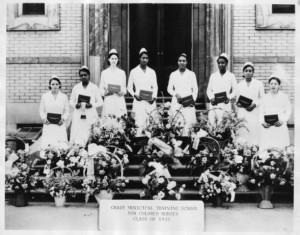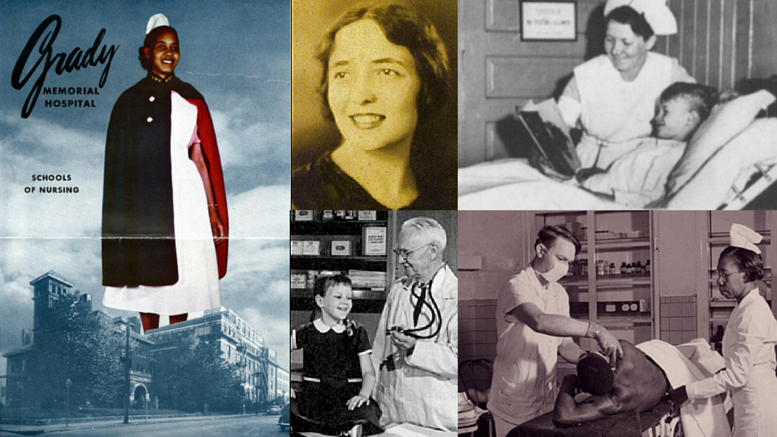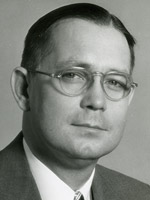
Pictured (L to R, top to bottom): Historical Grady Memorial Hospital promotional ad; Evangeline T. Papageorge; 1950s Grady children’s ward nurse and patient; R. Bruce Logue and patient; Grady staff and patient (date unknown)
1896 A children’s ward opens at Grady Memorial Hospital—the first in Georgia and reportedly the first in the Southeast.
1920 The first women of color to be certified as nurses by the state of Georgia graduate from Grady’s Municipal Training School for Colored Nurses.

Students of the Grady Municipal Training School for Colored Nurses holding their diplomas in front of the Albert Steiner Ward, Atlanta, 1933.
1921 Grady physician William R. Smith performs Georgia’s first successful open-heart surgery, setting the stage for Grady’s world-class trauma center.
1923 Georgia’s first cancer specialty clinic, the Steiner Clinic, is established at Grady. By 1930, Steiner is the largest comprehensive cancer hospital in the world.
1929 Evangeline T. Papageorge is the first woman appointed to Emory’s full-time medical faculty.
1942 Emory physicians Eugene A. Stead, Jr. and James Warren bring national recognition to Grady by establishing Georgia’s first cardiac catheterization lab, one of only three such facilities in the world at the time.
1943 Elizabeth Gambrell is the first woman to attend Emory University School of Medicine.
1946 R. Bruce Logue, often called the “father of cardiology at Emory,” establishes Emory’s first cardiology residency at Grady.
1949 Emory opthalmogist F. Phinizy Calhoun, Jr. helps establish the Grady Clay Memorial Eye Clinic (the fifth “eye bank” to be established in the United States) for corneal-transplant patients.
1951 Emory heart surgeon Osler Abbott performs the South’s first successful intracardiac operation.
Other notable firsts:
- In the 20th century, Grady established Georgia’s only polio center. In fact, it was volunteer Emory School of Medicine faculty member and renowned medical leader James E. Paullin who attended President Franklin D. Roosevelt when he died in Warm Springs.
- Paullin was also the first physician in Georgia to prescribe insulin for diabetes and one of the first to use the Wassermann test for detecting syphilis.
- Grady was one of the earliest hospitals in the United States to have a dialysis machine.
- Other early innovations adopted by Grady include the X-ray machine, diet therapy (followed by studies in nutritional research), safe blood transfusions, sulfa drugs, and the establishment of a blood bank.
Related Links/Sources
• The Legacy of Emory at Grady: Grady Memorial Hospital
• Raising the Bar: 150 Years of a Medical School in Motion
• Grady Health System
• Emory University School of Medicine
• Emory University Department of Medicine
• Jordan Messler’s April 2015 presentation at Medicine Grand Rounds
• A Marriage Made in Atlanta
• Emory at Grady


